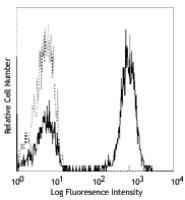-
Sign In
-

-
 Sony Biotechnology
Sony Biotechnology
-

-
 Sony Biotechnology
Sony Biotechnology
Purified anti-human CD3
Antibodies Single
Sony
UCHT1
Other
Mouse IgG1, κ
Human
2102005
$25.00
Description
CD3ε is a 20 kD chain of the CD3/T-cell receptor (TCR) complex which is composed of two CD3ε, one CD3γ, one CD3δ, one CD3ζ (CD247), and a T-cell receptor (α/β or γ/δ) heterodimer. It is found on all mature T cells, NKT cells, and some thymocytes. CD3, also known as T3, is a member of the immunoglobulin superfamily that plays a role in antigen recognition, signal transduction, and T cell activation.
Formulation
Phosphate-buffered solution, pH 7.2, containing 0.09% sodium azide.Recommended Usage
Each lot of this antibody is quality control tested by immunofluorescent staining with flow cytometric analysis. For flow cytometric staining, the suggested use of this reagent is ≤0.25 microg per million cells in 100 microL volume. It is recommended that the reagent be titrated for optimal performance for each application.
References
1. Salmeron A, et al. 1991. J. Immunol. 147:3047. (IP)
2. Graves J, et al. 1991. J. Immunol. 146:2102. (Activ)
3. Lafont V, et al. 2000. J. Biol. Chem. 275:19282. (Activ)
4. Ryschich E, et al. 2003. Tissue Antigens 62:48. (IHC)
5. Thompson AG, et al. 2004. J. Immunol. 173:1671. (Activ)
6. Sakkas LI, et al. 1998. Clin. Diagn. Lab. Immun. 5:430. (IHC)
7. Mack CL, et al. 2004. Pediatr. Res. 56:79. (IHC)
8. Thakral D, et al. 2008. J. Immunol. 180:7431. (FC) PubMed
9. Van Dongen JJM, et al. 1988. Blood 71:603. (WB)
10. Yoshino N, et al. 2000. Exp. Anim. (Tokyo) 49:97. (FC)
11. Pollard, K. et al. 1987. J. Histochem. Cytochem. 35:1329. (IHC)
12. Luckashenak N, et al. 2013. J. Immunol. 190:27. PubMed
13. Laurent AJ, et al. 2014. PLoS One. 9:103683. PubMed
14. Li J, et al. 2015. Cancer Res. 75:508. PubMed


